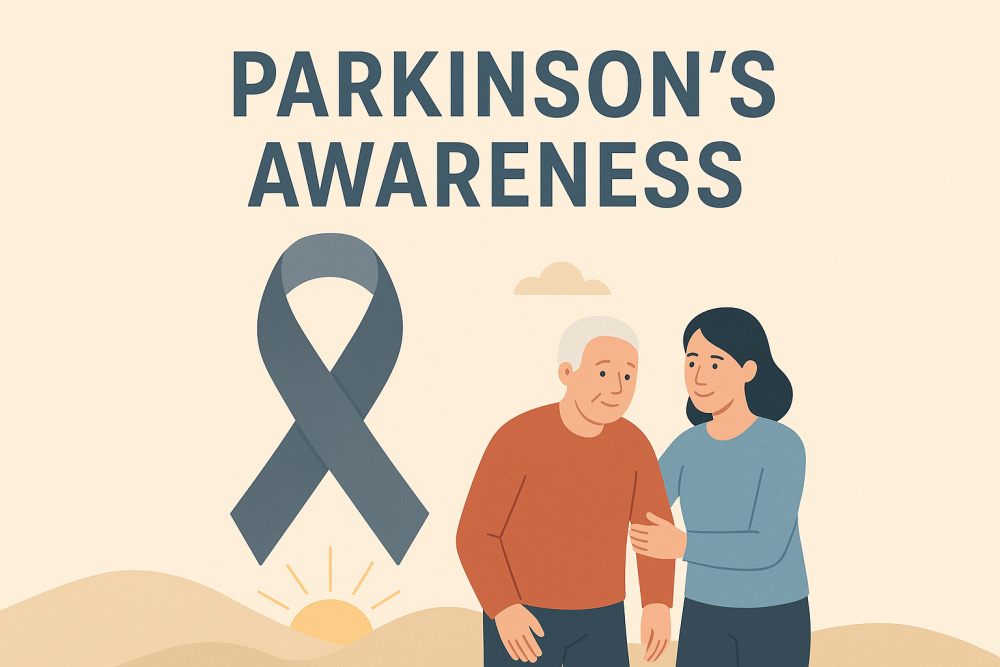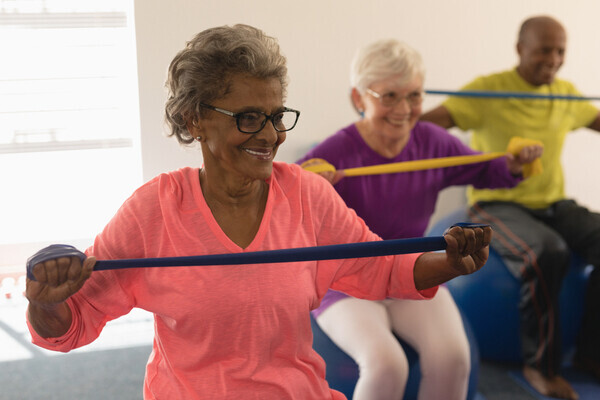
posted 13th October 2025
Parkinson’s Disease and Exercise: Evidence-Based Movement Therapy for Better Outcomes (Part 1A)
Key Takeaways
- Regular exercise at 150+ minutes per week significantly improves motor symptoms, balance, and quality of life in Parkinson’s disease patients according to NICE guidelines and Cochrane reviews.
- Structured physiotherapy programs combining aerobic, strength, and balance training can slow disease progression and reduce fall risk by up to 60%.
- High-intensity exercise (70-80% max heart rate) shows neuroprotective effects and may preserve dopamine-producing neurons in early-stage Parkinson’s.
- Exercise benefits are dose-dependent — starting early with 2.5+ hours weekly provides superior outcomes compared to delayed or minimal activity.
- Evidence-based physiotherapy supervision ensures safe, effective exercise prescription tailored to individual Parkinson’s symptoms and disease stage.
When Sarah received her Parkinson’s disease diagnosis at age 58, her neurologist delivered unexpected advice alongside her medication prescription: “Exercise isn’t optional — it’s medicine.” This recommendation reflects a fundamental shift in how we treat Parkinson’s disease, where physical activity has evolved from a supportive therapy to an essential, evidence-based intervention that can actually slow disease progression.
Parkinson’s disease affects over 145,000 people in the UK, causing progressive loss of dopamine-producing neurons in the substantia nigra region of the brain. This neurodegeneration leads to the characteristic motor symptoms of bradykinesia, rigidity, tremor, and postural instability, alongside significant non-motor symptoms including cognitive impairment, sleep disturbances, and mood changes. While there’s no cure for this neurodegenerative process, mounting research shows that structured exercise programs can dramatically improve outcomes and potentially modify the disease course itself.
Research shows that people with Parkinson’s disease who engage in regular, structured physical activity experience better quality of life compared to those who remain sedentary. Clinical trials consistently demonstrate that exercise provides neuroprotective effects, with some studies suggesting it may be as effective as drug therapy for certain motor symptoms. This evidence has led the National Institute for Health and Care Excellence (NICE), Parkinson’s UK, and the Parkinson’s Foundation to position exercise as a cornerstone of comprehensive disease management.

At Estuary Physio, we’ve witnessed firsthand how evidence-based exercise prescription can transform the lives of people with Parkinson’s disease. Our specialized neurological physiotherapists design individualized programs based on the latest research, ensuring each patient receives the optimal combination of aerobic exercise, resistance training, and balance exercises to address their specific symptoms and stage of disease.
The Scientific Foundation: Why Exercise is Essential Medicine for Parkinson’s Disease
The pathophysiology of Parkinson’s disease involves the progressive loss of dopamine-producing neurons in the substantia nigra, disrupting the delicate balance of neurotransmitters that control movement, coordination, and various non-motor functions. This neurodegeneration affects the basal ganglia circuitry, leading to the characteristic symptoms that define the condition. However, emerging research reveals that physical activity can trigger powerful neuroplastic responses that help compensate for this neuronal loss.
The NICE Clinical Guideline NG71 explicitly recommends structured physiotherapy and exercise as first-line non-pharmacological interventions for all people with Parkinson’s disease, regardless of disease stage. These guidelines, updated in 2017, emphasize that exercise should not be viewed as complementary to medication but as an integral component of comprehensive care. The recommendations specify that programs should include “exercise to improve motor function, strength, flexibility, and balance” with duration, frequency, and intensity tailored to individual capabilities.
Cochrane systematic reviews, considered the gold standard of evidence-based medicine, have consistently demonstrated the effectiveness of exercise interventions for both motor and non-motor symptoms of Parkinson’s disease. A comprehensive 2013 Cochrane review analyzing 39 randomized controlled trials found significant improvements in physical functioning, health-related quality of life, and specific motor symptoms including gait speed, balance, and functional mobility. Importantly, these benefits were observed across different types of exercise and disease stages.
Perhaps most compelling is research from Parkinson’s UK showing that people maintaining 2.5 or more hours of physical activity weekly experience 50% slower progression of symptoms over 24 months compared to those exercising less. This dose-response relationship suggests that exercise benefits are directly related to the amount and intensity of activity performed. The research indicates that higher physical activity levels are associated with better motor function, improved cognitive function, and reduced risk of developing movement-disorder complications.
When comparing exercise benefits to medication effects, studies reveal remarkable similarities in certain domains. While drug therapy remains essential for managing Parkinson’s disease symptoms, high intensity exercise programs can produce comparable improvements in specific areas like balance, gait speed, and postural stability. Importantly, exercise provides additional benefits that medications cannot offer, including improved cardiovascular health, enhanced mood, better sleep quality, and potential neuroprotective effects that may slow the underlying neurodegenerative process.
The mechanism by which exercise exerts these benefits involves multiple pathways. Physical activity promotes the release of neurotrophic factors like brain-derived neurotrophic factor (BDNF), which support neuron survival and encourage the formation of new neural connections. Exercise also enhances mitochondrial function in brain cells, potentially slowing the cellular dysfunction that characterizes Parkinson’s disease. Additionally, regular physical activity appears to increase dopamine release in the striatum and improve the efficiency of remaining dopaminergic pathways.
Evidence-Based Benefits of Structured Exercise Programs
The therapeutic effects of properly designed exercise programs extend far beyond general fitness improvements, addressing the complex constellation of symptoms that define Parkinson’s disease. Research consistently demonstrates that structured physical activity interventions produce measurable improvements across multiple domains, from core motor symptoms to often-overlooked non-motor manifestations that significantly impact daily living.
Motor symptom improvements represent the most visible and well-documented benefits of exercise in Parkinson’s disease. Studies using the Movement Disorder Society-Unified Parkinson’s Disease Rating Scale (MDS-UPDRS), the gold standard for measuring symptom severity, show significant reductions in bradykinesia, rigidity, and gait freezing episodes following structured exercise programs. One landmark study found that participants in a high intensity aerobic exercise program maintained stable MDS-UPDRS scores over six months, while the control group experienced typical disease progression with score increases averaging 3.2 points.
Gait improvements are particularly notable, with research demonstrating increased stride length, improved walking speed, and reduced freezing episodes. Treadmill training protocols have shown remarkable success in restoring more normal walking patterns, with some patients achieving 20-30% improvements in gait speed and stride length. These improvements translate directly into enhanced mobility for daily activities like grocery shopping, navigating crowded spaces, and maintaining independence in the community.
Balance and fall prevention represent critical areas where exercise intervention shows exceptional efficacy. Clinical trials consistently report 50–60% reductions in fall risk among participants completing comprehensive balance training programs. This dramatic improvement stems from exercise-induced enhancements in proprioception, muscle strength, reaction time, and postural control strategies. Given that falls represent one of the leading causes of injury and hospitalization in people with Parkinson’s disease, this benefit alone justifies exercise prescription.
The cognitive benefits of exercise in Parkinson’s disease are increasingly recognized as research reveals the interconnected nature of motor and cognitive function. Studies show improvements in executive function, processing speed, working memory, and attention following structured exercise programs. These cognitive enhancements are particularly valuable for people with mild cognitive impairment associated with Parkinson’s disease, potentially delaying progression to dementia. The mechanism appears related to exercise-induced neuroplasticity created through increased BDNF production and enhanced cerebral blood flow.

Non-motor symptom management through exercise offers profound quality-of-life improvements that extend beyond movement. Depression affects up to 50% of people with Parkinson’s disease, and exercise programs consistently demonstrate antidepressant effects comparable to pharmaceutical interventions. Sleep disturbances, another common and debilitating aspect of the condition, show significant improvement with regular physical activity, with patients reporting better sleep quality, reduced daytime fatigue, and more stable sleep–wake cycles.
Constipation, affecting nearly 80% of people with Parkinson’s disease, responds particularly well to aerobic exercise and core-strengthening programs. The improved gut motility from regular physical activity often reduces the need for laxatives and improves overall digestive health. Similarly, exercise programs addressing respiratory function help combat the restrictive breathing patterns common in Parkinson’s disease, improving voice quality and reducing the risk of respiratory complications.
The neuroprotective effects of exercise represent perhaps the most exciting area of current research. Animal models consistently show that exercise can protect dopamine-producing neurons from degeneration and may even promote the regeneration of damaged neural pathways. While human studies are still emerging, early evidence suggests that people who exercise regularly from the time of diagnosis may experience slower disease progression and better long-term outcomes. High-intensity exercise appears particularly promising for neuroprotective effect, with some studies indicating that vigorous physical activity may preserve more dopaminergic function over time.
Types of Exercise for Parkinson’s Disease Management
Effective Parkinson’s disease management requires a multimodal approach to exercise that addresses the diverse symptoms and functional challenges characteristic of this complex neurological condition. Rather than relying on a single type of physical activity, evidence-based practice emphasizes combining different exercise modalities to target specific symptoms while promoting overall health and function. Each type of exercise contributes unique benefits, and the optimal program typically integrates multiple approaches tailored to individual needs and disease stage.
Aerobic Exercise Programs
Aerobic exercise forms the foundation of neuroprotective intervention for people with Parkinson’s disease, with mounting evidence suggesting that cardiovascular training may be the most powerful single intervention for slowing disease progression. The key lies in achieving sufficient intensity to trigger the neurobiological cascades that promote brain health and neuroplasticity.
High-intensity interval training (HIIT) protocols have emerged as particularly effective, with research demonstrating optimal benefits when participants exercise at 70–80% of their maximum heart rate for sustained periods. These intense exercise sessions, typically performed three times weekly, appear to maximize the release of neurotrophic factors while promoting mitochondrial biogenesis in brain cells. Studies show that participants completing six months of high-intensity aerobic exercise maintain better motor function and may experience actual improvements in certain symptoms rather than the typical progressive decline.
Continuous aerobic exercise, including cycling, treadmill walking, and swimming, provides more accessible options for many people with Parkinson’s disease while still delivering significant benefits. Cycling has shown particular promise, possibly due to the rhythmic, repetitive nature of the movement that helps overcome bradykinesia. Swimming offers the advantage of reducing fall risk while providing full-body cardiovascular training, making it ideal for people with balance issues or advanced symptoms.
Dance-movement therapy has emerged as one of the most effective and enjoyable forms of aerobic exercise for people with Parkinson’s disease. Argentine tango, in particular, has been extensively studied, with research showing superior improvements in gait, balance, and walking speed compared to traditional exercise programs. The complex footwork, partner interaction, and musical rhythm appear to engage multiple brain networks simultaneously, promoting motor coordination and cognitive function. Ballet-based programs offer similar benefits while emphasizing posture, grace, and amplitude of movement.
Boxing programs, particularly non-contact boxing like Rock Steady Boxing, combine aerobic exercise with coordination training, providing excellent cardiovascular benefits while improving hand–eye coordination, reaction time, and cognitive function. The varied movements — including jabbing, footwork, and defensive maneuvers — challenge participants to make quick decisions while maintaining balance and coordination. These programs often incorporate rhythm and music, further enhancing their neurological benefits.
Strength and Resistance Training
Progressive resistance training addresses the muscle weakness and reduced power generation that often accompany Parkinson’s disease, particularly as the condition progresses. Research demonstrates that structured strength-training programs can significantly improve muscle strength, functional mobility, and even certain motor symptoms when performed with adequate intensity and progression.
Effective resistance-training protocols for Parkinson’s disease typically involve 2–3 sets of 8–12 repetitions at 70–80% of one-repetition maximum (1RM), performed 2–3 times weekly. This intensity appears necessary to trigger meaningful adaptations in muscle strength and power. Studies show that participants completing progressive resistance-training programs demonstrate improvements not only in strength measures but also in functional activities like rising from chairs, climbing stairs, and maintaining balance during daily activities.
Functional strength exercises that mirror activities of daily living provide particularly relevant benefits. Sit-to-stand exercises address one of the most common functional limitations in Parkinson’s disease, helping people maintain independence in transfers. Step-ups and stair-climbing exercises improve lower-extremity power and coordination. These functional movements can be progressed by adding resistance, increasing height, or incorporating unstable surfaces as strength improves.
Explosive power training represents an important but often overlooked component of strength training for Parkinson’s disease. The ability to generate force rapidly becomes compromised in this condition, contributing to balance problems and fall risk. Exercises like jump squats, medicine-ball throws, and rapid-stepping movements help maintain and improve power generation. These exercises must be carefully supervised and adapted to individual capabilities, but research shows they can significantly improve functional performance.
Core-stability programs targeting postural control and trunk strength form an essential component of strength training for people with Parkinson’s disease. The postural instability characteristic of this condition often stems from weakness and poor coordination of the deep stabilizing muscles. Targeted core exercises, including planks, bridges, and rotational movements, help improve posture and reduce the risk of falls while enhancing overall functional capacity.
Balance and Coordination Training
Balance impairment represents one of the most disabling aspects of Parkinson’s disease, contributing to falls, injuries, and reduced quality of life. Specialized balance-training programs can significantly improve postural control and reduce fall risk, with effects often exceeding those achieved through medication alone.
Dual-task training, which combines cognitive and motor challenges, prepares people with Parkinson’s disease for real-world situations where attention must be divided between multiple demands. Examples include walking while counting backwards, balancing while solving math problems, or performing hand movements while maintaining a standing position. This type of training improves the ability to maintain balance and motor control even when cognitive resources are divided, a common challenge in daily life.
Proprioceptive exercises that challenge the body’s position sense help compensate for the sensory deficits that contribute to balance problems in Parkinson’s disease. Training on unstable surfaces like foam pads, balance boards, or wobble cushions forces the nervous system to rely more heavily on proprioceptive feedback. Sensory-integration activities that manipulate visual and vestibular inputs further challenge the balance system and promote adaptation.
Gait training incorporating cueing strategies addresses the specific walking difficulties characteristic of Parkinson’s disease. Auditory cues, such as a metronome or rhythmic music, help overcome freezing episodes and promote more consistent stride patterns. Visual cues, including lines on the floor or laser devices, can help maintain stride length and reduce shuffling. These strategies can be practiced during therapy sessions and incorporated into home-exercise programs for ongoing benefit.
Tai chi and qigong have garnered significant research attention for their balance benefits in Parkinson’s disease. These ancient practices combine slow, controlled movements with breathing techniques and meditation, providing a comprehensive approach to balance training. Multiple randomized controlled trials demonstrate that regular tai chi practice can reduce fall risk, improve postural stability, and enhance overall quality of life. The meditative aspects may also provide additional benefits for mood and stress management.
Flexibility and Range of Motion
Flexibility training addresses the rigidity and reduced range of motion that characterize Parkinson’s disease, helping maintain functional movement patterns and prevent contractures. The approach to stretching in Parkinson’s disease differs from traditional flexibility training, requiring specific attention to the unique movement characteristics of this condition.
Dynamic stretching protocols appear more effective than static stretching for managing bradykinesia and rigidity. Large-amplitude movements performed through full range of motion help combat the tendency toward smaller, restricted movements. The LSVT BIG program principles, originally developed for physical therapy, emphasize the importance of thinking “big” and moving with exaggerated amplitude to overcome the reduced movement patterns typical of Parkinson’s disease.
Voice and facial exercises, while not traditionally considered flexibility training, address the reduced amplitude of movements in the face, throat, and respiratory muscles. These exercises help maintain vocal quality, improve swallowing function, and prevent the masked facial expression common in Parkinson’s disease. Respiratory exercises focusing on diaphragmatic breathing and chest expansion can improve voice quality while addressing some non-motor symptoms.
Joint-mobility maintenance becomes increasingly important as Parkinson’s disease progresses, preventing contractures and maintaining functional movement patterns. Regular range-of-motion exercises for all major joints help preserve the flexibility necessary for daily activities. These exercises are particularly important for the neck, shoulders, and spine, areas commonly affected by the postural changes associated with Parkinson’s disease.
Frequently Asked Questions
How much exercise should I do for Parkinson’s disease?
Guidelines from NICE and Parkinson’s UK recommend at least 150 minutes of moderate or 75 minutes of vigorous exercise each week. Evidence suggests that 2.5 hours or more weekly produces the greatest benefits for slowing symptom progression.
Which types of exercise are most effective?
A combination of aerobic, strength, balance, and flexibility training gives the best results. Activities such as cycling, brisk walking, tai chi, dance-movement therapy, and resistance training each target different Parkinson’s symptoms.
Can exercise really slow the progression of Parkinson’s disease?
Research shows that people who stay active for 2.5 hours or more weekly experience up to 50 percent slower symptom progression compared with those who are less active. Exercise stimulates neuroplasticity and supports dopamine-producing neurons.
Is it safe to exercise at high intensity?
Yes – when supervised and medically cleared. High-intensity sessions (70–80 percent of maximum heart rate) provide neuroprotective benefits, but programs should be designed and monitored by a qualified neurological physiotherapist.
What are the best exercises for improving balance?
Balance-specific programs, tai chi, and gait-cueing exercises have the strongest evidence for reducing falls. Practising on stable and slightly unstable surfaces helps retrain postural control.
Do I need special equipment?
Not necessarily. Many Parkinson’s exercises use body weight, chairs, resistance bands, or household items. Cycling or treadmill walking can be added for aerobic training if available.
Reviewed by Barry Ford BSc, Chartered Physiotherapist.
Learn more about our Parkinson’s Physiotherapy Service, our Parkinson’s Condition Information Page, and related Home Physio and Neurological Physio services at Estuary Physio.






